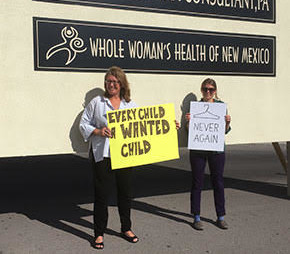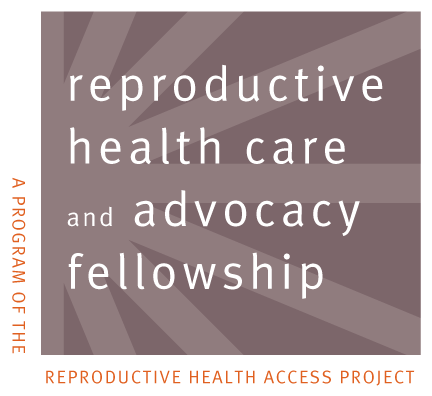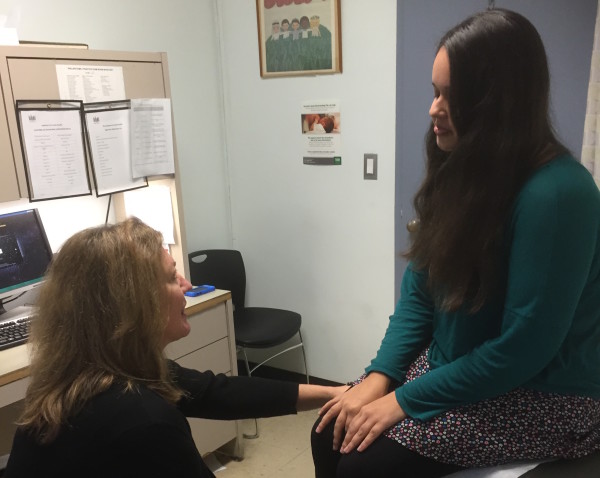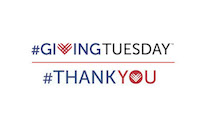Nov 06

Help Us Protect Access to Sexual and Reproductive Health Care Today!
Newsletter/December 2015
 The Texas state legislature has passed laws that are severely restricting access to abortion in the state. A recent study estimates that between 100,000 and 240,000 women in Texas have attempted self-induced abortions as a result of these strict restrictions on abortion provision. The Reproductive Health Access Project (RHAP) medical director, Dr. Linda Prine has seen first hand the impact Texas laws have had on women. She travels to Las Cruces, New Mexico, 30 miles from the Texas border, once a month to work at Whole Women’s Health of New Mexico. There she provides abortion care to the women of New Mexico and Texas. Linda recently shared with us what her work in Las Cruces means to her.
The Texas state legislature has passed laws that are severely restricting access to abortion in the state. A recent study estimates that between 100,000 and 240,000 women in Texas have attempted self-induced abortions as a result of these strict restrictions on abortion provision. The Reproductive Health Access Project (RHAP) medical director, Dr. Linda Prine has seen first hand the impact Texas laws have had on women. She travels to Las Cruces, New Mexico, 30 miles from the Texas border, once a month to work at Whole Women’s Health of New Mexico. There she provides abortion care to the women of New Mexico and Texas. Linda recently shared with us what her work in Las Cruces means to her.
“I decided I needed the experience of working in an area where abortion access is severely restricted because I train doctors who I hope will work in low resource settings. I should know what it’s like so I can, in turn, teach others to be prepared. Working in these areas is distinctly different from working in New York City, because you’re often the only one in a low resource setting who knows how to perform an abortion.
“Besides the benefits to me as a teacher, working in Las Cruces also allows me to provide much needed reproductive health care to the women of West Texas. This part of Texas has only a handful of abortion clinics to service millions of women. Because of Texas laws, women have to make a minimum of 3 visits to get the pills for a medication abortion. The visits have to be 2 days apart, so it takes women 5 days just to get started on the medication abortion, whereas in New Mexico or New York, it takes one day. Furthermore, medication abortions in Texas are only performed up to 7 weeks. Surgical abortion is only available for women up to 20 weeks. These restrictions make it almost impossible to get an abortion in Texas. I see a full spectrum of patients from Texas coming to Las Cruces just to get an abortion. Some patients can afford to fly in from Dallas, while some have more difficult circumstances. I recently had a patient seeking an abortion who lives in her car with her daughter.
“Unlike in my practice in New York City, there are protesters out front of the clinic every day in Las Cruces. You leave the clinic and you don’t know if somebody is following you home. At RHAP, we train providers to be advocates in their community, and create support networks so these stressful experiences can be shared.”
Dr. Prine has been working on developing local support in Las Cruces. She has developed friendships with many of the people and feels at home when she visits. She stays with her friend Sharon who walks Dr. Prine around town, introducing her as “Linda, my friend who provides abortions!”
The Reproductive Health Care and Advocacy Fellowship is a 1-year clinical training program that develops and fosters clinical leaders who will promote and teach full-spectrum reproductive health care within family medicine. Fellows spend the year as teachers in training, learning to perform and teach reproductive health care procedures. This year, RHAP is sponsoring 4 fellows, three in New York and one in Massachussets. Meet are our 2015-2016 Fellows!
is a 1-year clinical training program that develops and fosters clinical leaders who will promote and teach full-spectrum reproductive health care within family medicine. Fellows spend the year as teachers in training, learning to perform and teach reproductive health care procedures. This year, RHAP is sponsoring 4 fellows, three in New York and one in Massachussets. Meet are our 2015-2016 Fellows!
Danit Brahver, MD
“I grew up in northern New Jersey in the suburbs of New York City, attended college in Pennsylvania, and returned to my home state for medical school at Rutgers University Robert Wood Johnson Medical School in Camden, NJ. The residency match landed me in Boston at the Tufts University Family Medicine Residency program, and I am ecstatic to be the first fellow at Tufts piloting the Massachusetts arm of the Reproductive Health Care and Advocacy Fellowship! My passion for family medicine, underserved care, and reproductive health provision is rooted deeply in reproductive justice and social equity (Thanks, Mom!). I chose to do the RHAP fellowship to bolster my procedural skills, to gain real comfort in teaching residents, and to learn the nuts and bolts of family planning practice integration. After graduation, I hope to join a family medicine residency program in need of a reproductive health trainer to continue teaching and providing comprehensive women’s health services in a shortage area.”
Razel Remen, MD
“I am from a working class family from Brooklyn, NY, the first in my family to become a physician. I have always had a passion for women’s health, in residency I discovered that I also loved pediatrics, so family medicine seemed to be the ideal place where I could do both women’s health and pediatrics. I did my residency training in Tuscaloosa, Alabama. I started residency with the plan of doing an obstetrics fellowship. I think coming from New York City I really had no idea how dire the situation of reproductive health is for most women outside of major US cities. I was also struck by the lack of reproductive health training outside of obstetrics as well as the emotional and economic impact that unplanned, unwanted pregnancies had on women and their families. I applied for the Reproductive Health Care and Advocacy Fellowship because I wanted to learn to become a well-trained provider as well as train the next generation of providers. I am also deeply committed to learning how to change the many policies which negatively impact reproductive health.”
Martha Simmons, MD
“I grew up in the suburbs of Boston and actually lived in and around Boston for over 25 years. I went to Tufts undergrad and stayed at Tufts for medical school. I actually didn’t know much about family medicine until medical school and for a long time I thought I wanted to be a pediatrician. However, when I started medical school, I was lucky enough to get involved with the Tufts student-run free clinic. Through working with the patients there and getting to work with the amazing passionate family medicine doctors who staffed the clinic I realized that I wanted to do primary care and be a family doctor. Providing reproductive health care is important to me, because I think it’s where I can really make the most difference in women’s lives. Helping a woman control when she becomes pregnant and her family size can influence so many aspects of her health and life. I chose to apply to this fellowship in order to become an expert in providing and teaching reproductive health care procedures. As a “trainer in training”, I receive instruction in teaching procedures to medical students and residents which is invaluable for my planned career in academic medicine as faculty at a family medicine residency program.”
Seema Shah, MD
“I was born and raised in Houston, Texas and have traveled a bit before coming to New York City. I was an anthropology major for undergrad in Chicago, and then spent a year in India working with various women’s health NGOs on reproductive health issues and access to care. These experiences sparked my drive to pursue degrees in public health and family medicine with a focus in reproductive/sexual health. I finished my residency in June 2015, and this year, I am fortunate to be a Reproductive Health Care and Advocacy Fellow. The fellowship provides me additional family planning and advocacy training, research, and teaching opportunities, and an incredible network of similar physicians/advocates in the field. With this training, I plan to provide full-spectrum reproductive health care in primary care settings, teach students/residents, and continue reproductive health advocacy. I also hope to provide family planning services in areas of need locally and internationally.”
We are now accepting applications for the 2016-2017 Reproductive Health and Advocacy Fellowship. Learn More.
As a life-long feminist, Virginia Sobol has always supported reproductive rights, but working full-time throughout her career in marketing and corporate communications, she had very little time to pursue this passion. Then in 2012, she decided to work part-time, consulting for small real estate firms. This opened up a lot more time to focus on social advocacy work.
Virginia first joined RHAP as a volunteer on the “V to Shining V” 10-year anniversary event committee. She was very impressed by the organization as well as the other volunteers. As Virginia explains, “This was a really positive experience since I was able to be involved and apply my professional skills in a meaningful way. As a volunteer, I was also able to see firsthand how well-run RHAP is. You can really see the results and they get so much done on a limited budget. This is really what inspired me to become a donor.”
In addition, Virginia says having a 17-year-old daughter motivates her to support the Reproductive Health Access Project. “As a mother, this is something that you have to be concerned about. Seeing women’s reproductive rights in the United States being chipped away reminded me that I should be involved. I want to make sure my daughter has access to all the services she might need. I know my donations to RHAP—and particularly, its fellowship program—make a big impact and help ensure that more women have access to the basic reproductive health care they deserve.”
We are so grateful to Virginia for her support of the Reproductive Health Access Project both as a volunteer and now as a valued donor.
Linda Prine MD, Natalie Hinchcliffe DO, Shauna Gallagher MD
 Too many times we hear the refrain: “We don’t need to do abortions in our family medicine practice, we have a XXX (fill in the blank with the name of your local abortion care clinic) in town.” Comments like these reflect a lack of understanding of what so many women’s lives are like and just how difficult it can be to access care at a dedicated family planning clinic. Here are our (patients’) true stories:
Too many times we hear the refrain: “We don’t need to do abortions in our family medicine practice, we have a XXX (fill in the blank with the name of your local abortion care clinic) in town.” Comments like these reflect a lack of understanding of what so many women’s lives are like and just how difficult it can be to access care at a dedicated family planning clinic. Here are our (patients’) true stories:
Shauna’s story:
My patient came into the clinic with a man who was supposedly her partner, after a positive urine pregnancy test at home. Nadia was a 26 year old non-English speaking woman who appeared quite anxious, had poor eye contact throughout our encounter and didn’t interact with this man throughout discussion. He chose not to involve himself in the conversation, sitting silently in the corner staring at the ground.
I learned quickly that her medical history included an ectopic pregnancy, a pregnancy which implants in the fallopian tubes. For Nadia, the ectopic required an extensive surgery for resolution. I had initially assumed that her fidgeting was a result of her troubled medical history. I offered her options for continuing the pregnancy or not, explaining that we provided care in our health center either way. She replied with hesitance that this was a surprise but she would continue the pregnancy. I explained that, with her ectopic history, we should do a transvaginal ultrasound today and she quickly told her partner that she would feel more comfortable if he stepped outside. He hesitated, so I stepped in quickly and assured him that we would bring him back into the room shortly.
Once he left the room, I reiterated to the patient her available options. She immediately looked at me in desperation stating that she wanted an abortion and that he must not find out under any circumstance. She assured me that she was not in any danger, lived in a safe place but this was by no means the right time for her to have a child. She had recently started a new college program that she had invested in with her own money after working and saving for many years. I immediately assured her that she was in the right place and her partner did not need to know what we had discussed. I was happy to let her know that we could provide her with an abortion which could be done here at the clinic. She expressed a big sigh of relief but remained fearful, anxious and felt that she needed to report back to her partner as soon as possible.
She ended up getting her abortion at our clinic the following day, in a quick visit, through a collaborative effort from our providers. I wondered if I had needed to refer her to an abortion clinic for her procedure if she would have made it. I doubt she was allowed to travel to her doctors’ appointments without her partner’s supervision.
The take home lesson for me is that going forward I will always ask the partner to step out of the room during options counseling visits. I now wonder how many women aren’t able to access their preferred choice when options counseled, aren’t making it to the abortion clinic when referred, or not even getting the right message to their provider of what they really want, simply from a barrier of not having the partner step out of the room.
Natalie’s story:
My patient was 12 years old. No one knew Annie was having sex—especially not her parents. The nursing note in the chart said “here for a pregnancy test”, so when I walked into the room I was startled to see a nervous child. She looked every bit her young age and was terrified, sitting next to her equally young and nervous boyfriend.
She had come into clinic worried she was pregnant when she missed her period. When I counseled her on all her options, taking care to make sure she understood everything, it was clear she knew what she wanted: she had come here for an abortion. She knew about our clinic because her boyfriend’s aunt had come to us for her own abortion. I asked her if she wanted to talk to a parent or another adult she trusted about her decision. Her eyes widened in fear as she told me no one could know. When I spoke to her without her boyfriend in the room, she was even more adamant. I told her we could perform her abortion that day and watched her shoulders drop and her face soften in relief.
She came to see me twice, once for her abortion and once for follow up. Each time she came directly after school with her boyfriend and told her parents she was staying late at school to study. She couldn’t miss school to make an appointment because her school called parents if the kids were absent and if the parents had not called in the absence. There would have been no way for her to miss school for an appointment at the local abortion clinic. Our clinic’s teen friendly hours allowed her to make the right choice for her. It also allowed us to take extra time to talk through the pelvic exam, and to have the support of her boyfriend by her side during the procedure.
When I saw her for her follow up appointment, she and her boyfriend were joking and laughing. They were playing on the rolling chairs, teasing each other about the pelvic models—they were having fun. She was no longer the nervous girl I had met the week before, she was a kid again. She ended up choosing an IUD for contraception which can last her through middle school and high school before she needs a new one.
Linda’s story:
My patient’s husband took her everywhere. Her religion and culture dictated that she not travel alone. Magda had four children under the age of five and was exhausted. She came to me asking for birth control that her husband would not be able to detect, because he was trying to get her to have another child. But, when we did the pregnancy test, she was already pregnant! Magda broke down in sobs and begged me to help her. Her spouse was in the waiting room and she was terrified. There was no way he would take her to a family planning clinic, the only hope she had of getting an abortion was if I could give her one, in the privacy of our family medicine office, behind closed doors.
She was only one day late for her period. I explained the medication abortion process and that it was impossible for anyone to know the difference between it and a miscarriage. Or, for that matter (at that gestational age), it could just be a slightly late and slightly heavier period. She begged me to give her these medications, and to keep it a secret from her husband. She signed the consent, I gave her the medications. She asked me to explain her “miscarriage” to her husband, should he call me the next day when she began to bleed and I agreed.
Magda came back the next week for a follow up visit for her miscarriage and her pregnancy test was now negative and I inserted an IUD. We did discuss the helplessness she was experiencing in her marriage and I started to plant the seeds with her that perhaps our health center could help her in other ways to gain independence. She knows I will be her physician for the long haul, and that she can come to me with her children, who she hopes she will be able to give a better life to than what she is experiencing, especially her daughters.
These experiences reinforce for us that abortion services must be widely available, in the privacy of one’s own doctor’s office – just as was the original intention of Roe v Wade. As clinicians, every time we have to send women out of our practice to a stand alone health center that was created for the sole purpose of offering abortions, it contributes to the stigma associated with abortion. Not caring for them but sending them away implies to our patients that we disapproval of their choice.
Providing abortion care isn’t that complicated, especially medication abortion. Every primary care clinician can provide caring counseling and offer a pill.
State legislation mandating surgical centers and hospital privileges only makes abortion less caring and less available. The most vulnerable women, like our patients, are forced to be pregnant when they don’t want to be. Instead of giving women the space to have families on their own terms, parenthood is being forced on them, often the result of coercive relationships or other extremely difficult life circumstances. We encourage all family physicians who are patient-centered to offer abortion care in the privacy of their own offices, even if it means a fight with the state legislatures. If not us, then who?
All patient names and identifying information have been changed.
 On Tuesday, December 1, 2015, the Reproductive Health Access Project participated in the fourth annual #GivingTuesday campaign. This is a global day for giving back to the nonprofits you love and we are so grateful to everyone who helped make RHAP’s #GivingTuesday a success.
On Tuesday, December 1, 2015, the Reproductive Health Access Project participated in the fourth annual #GivingTuesday campaign. This is a global day for giving back to the nonprofits you love and we are so grateful to everyone who helped make RHAP’s #GivingTuesday a success.
This year, we nearly doubled our number of #GivingTuesday supporters and raised over $3,000 in just 24 hours! Your donations to RHAP allow us to train and support the next generation of reproductive health care providers, create new patient education materials and clinical tools, and promote the latest reproductive health research and best practices.
Thank you for your ongoing support and for helping to ensure that everyone has access to the comprehensive reproductive health care they need and deserve.
If you did not have the opportunity to support the Reproductive Health Access Project on #GivingTuesday, you can still #GiveAccess this giving season. Make your 100% tax-deductible, end-of-year gift today!
Subscribe to receive monthly updates from the Reproductive Health Access Project.
Your gift allows us to train and support health care providers across the United States so they can offer patients compassionate and comprehensive care.
Nov 06
